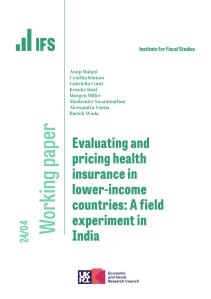Today the Prime Minister has announced plans to consult on reforms to disability benefits, following new forecasts from the Department for Work and Pensions and the Office for Budget Responsibility indicating a substantial increase in the number of people claiming health-related benefits in the coming years. Calculations by IFS researchers suggest that there are now 4.2 million working-age individuals – one in ten – in Great Britain claiming a health-related benefit. That number could rise to 5.4 million (12.4%) by 2028–29, a rise of more than 2 million since 2019–20, with the rapid increases in health-related benefits cases that began around the beginning of the pandemic projected to continue.
A new IFS report released today, funded by the abrdn Financial Fairness Trust, sheds more light on this worrying trend:
- There are now 4.2 million working-age individuals (10.2%) receiving at least one health-related benefit, compared with 3.2 million (7.9%) in 2019. This rise has been driven by large increases in the number of new claims. Before the pandemic, both incapacity benefits and disability benefits saw about 20,000 new claims per month. By November 2022, that had risen to 51,000 and 43,000 respectively.
- Calculations using forecasts from the Office for Budget Responsibility and the Scottish Fiscal Commission imply that there will be 5.4 million working-age individuals (12.4%) receiving a health-related benefit by 2028–29. This assumes that the rates of new awards will slow from their current levels, but still be far above the pre-pandemic norm. If the recent pace of new awards persisted, we estimate that the number of recipients in 2028–29 would be 5.8 million. If the rates returned to their pre-pandemic levels, our estimate would be 4.4 million recipients.
- As a result of the rise in cases, spending on disability benefits and incapacity benefits for working-age people rose by £12.8 billion to £48.3 billion between 2019–20 and 2023–24 (2024–25 prices). The latest forecasts imply a further rise, to £63.7 billion, by 2028–29 – a £28.1 billion increase in the space of a decade. For context, total expenditure on all working-age benefits in 2028–29 (including incapacity and disability benefits) is forecast to be £144 billion.
While the causes of the recent rise in incapacity and disability benefits are not yet well understood, the implications for government spending – not to mention the population’s health – are significant. Absorbing the additional costs would pile pressure on government finances. But the most straightforward response – tightening the system or cutting benefit amounts – would imply significant losses for many vulnerable households. Of course, neither would deal with underlying worsening health.
Exploring trends across age groups the report finds that:
- Today, one in six of those aged 60–64 receive a health-related benefit. But the recent rise in claiming has been greater among younger people, in proportional terms. For example, since 2019, the share of 25-year-olds on these benefits has risen from 4.9% to 7.0%, while the rise among 55-year-olds was from 11.4% to 13.4%.
- As a result of these increases, a 20-year-old today is about as likely to claim a health-related benefit as a 39-year-old was in 2019; a 35-year-old today is about as likely to claim as a 46-year-old in 2019; and a 55-year-old today is about as likely to claim as a 60-year-old in 2019.
- Mental health and behavioural disorders are the most common condition affecting benefit claimants, representing the primary condition for 41% of recent disability benefit claimants. But this average masks substantial variation by age: for 69% of new 25-year-old claimants, mental health and behavioural disorders were their primary condition, while this was the case for just 22% of new 55-year-old claimants.
Sam Ray-Chaudhuri, a Research Economist at IFS and an author of the report, said:
‘A year or so ago, it seemed plausible that the rapid rise in numbers claiming health-related benefits was a transitory pandemic-related phenomenon. That explanation now appears unlikely, and today’s new forecasts reflect this fact. The rising cost of these benefits, and what might be done in response, will be a pressing concern for the next government and make the already tough fiscal situation harder still. Unfortunately, designing the right policy response is made much more difficult by the lack of clarity on what is fuelling the rise.’
Mubin Haq, Chief Executive of abrdn Financial Fairness Trust, said:
‘Before the pandemic, around one in thirteen were claiming a health-related benefit. That is now set to rise to one in eight by the end of the decade. This matters as the growth in poor health and disabilities increases the likelihood of people being locked out of the workforce, at a time when the UK faces acute labour shortages. A range of factors is likely to be contributing to this rise, such as the pandemic, NHS waiting times and conditionality in the benefits system, but much remains unknown as to what is driving this growth.
‘Cutting or reducing access to benefits would lead to severe hardship for millions with additional needs and fail to address the underlying conditions we now face.’










